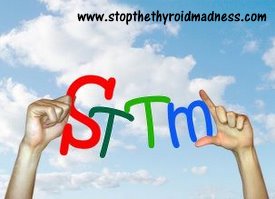Taking your temp, Selenium and RT3, TPA’s Autumn Newsletter, and HealthcheckUSA’s discount to STTM readers
NOTE: though this post was originally written in 2011, it can still contain relevant information for you today to consider, or do further research on.Â
(Photo graphic by thyroid patient Sam Aliyev of Azerbaijan, Baku city.)
TAKING YOUR TEMPERATURE CORRECTLY?? Possibly not.
Thanks to Dr. Broda Barnes, informed thyroid patients know the importance of taking one’s temperature, especially just before we get out of bed in the morning. According to Barnes, we can suspect a thyroid problem if that temp is below 97.8. Conversely, healthy thyroid function (or adequate treatment) would  put our before-rising temp from 97.8 to 98.2. (Menstruating females would need to be aware of higher temps right after ovulation.).
Today, we favor the mercury thermometer over digitals for accuracy. But are we using the mercury thermometer correctly? Maybe not.
A discussion between thyroid patients recently underscored the need to leave it in the mouth longer than the 5 minutes we thought was adequate. Thyroid patient Jennifer states: At 5 minutes it read 97.6, at 10 minutes it read 97.8 and at 15 minutes it read 98 degrees. After that, it stayed 98 degrees.  We then discussed the fact that manipulating the muscle in the back of throat could have caused the final temp. But her experiment, as well as others, underscored that we need to be holding that mercury thermometer in our mouths no less than five minutes, and ten is probably better.
DOES SELENIUM REALLY CAUSE A RISE IN REVERSE T3 (RT3)?
The above statement about selenium causing excess RT3 has oft been repeated from group to group for a few years. But it may be very wrong.
For example, this study shows selenium did not cause a rise in RT3, and in fact, lowered  it. Here is one which shows LOW levels of selenium can result in increased RT3. This medical book states that though RT3 comes from T4, it also concludes that  low selenium increases RT3.
In other words, Â though the enzymes that convert T4 to T3, Â and convert T4 to RT3, are selenium dependent to do their job, that doesn’t mean that selenium is going to increase your RT3. Â Bottom line, many thyroid patients love selenium, especially with its power to lower Hashimoto’s antibodies, and being anti-cancer. Suggested levels are no more than 400 mcg.
TPA’s AUTUMN NEWSLETTER IS OUT–many good articles!
TPA stands for Thyroid Patient Advocacy, and is a UK charity organization started by Sheila Turner. Check out the articles below in the latest newsletter.
Page 5:Â The Big Question – Is There an Anti-T3 Conspiracy. Â Eric Prichard critically questions why those in Endocrinology need to cite numerous anti-T3 studies, in spite of many other studies which reveal the activeness and superiority of T3. Is the UK and other dark age countries ever going to get it?
Page 9:  Why I Believe T3 Should Be the Very Last Treatment that Thyroid Patients Consider.  Don’t let UK’s Paul Robinson’s title fool you. He believes in the efficacy of T3, but underscores why it can be complex to dose with just T3. Especially compelling are what follows Paul’s article, titled MEMBERS SUCCESS STORY.  Story 1 is about an individual who, when dosing T3 in the early morning hours, was able to get off all adrenal meds. Story 2 is about a gal’s successful transition from T4 to T3.
Page 15:  Thyroid Patients Have Come a Long Way, Baby….But We Still Have a Way to Go!  Though there are now numerous patient groups on the net and many lives have changed, Janie Bowthorpe (yes, me) explains how many doctors still have a long way to go in understanding how T4 and TSH fail patients, just as desiccated thyroid or T3 have turned miserable lives around.
READING THIS BLOG POST VIA AN EMAIL NOTIFICATION??
If you want to respond to this post, click on the title at the top of the email, which will take you directly to the blog post on the STTM site. Then click on Comment. If YOU want to be notified by email, signup below on the lower right side.

